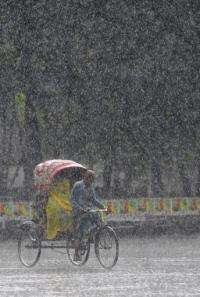A Bangladeshi rickshaw driver pedals his vehicle through a heavy downpour in Dhaka. Bangladesh has experienced its driest monsoon season for more than a decade despite heavy rains in neighbouring India and Pakistan that caused flooding, officials have said.
Bangladesh has experienced its driest monsoon season for more than a decade despite heavy rains in neighbouring India and Pakistan that caused flooding, officials said Wednesday.
Bangladesh received 139.5 centimeters (55 inches) of rain this monsoon, which runs from June to September, nearly 20 percent less than predicted by the meteorological office and the lowest rainfall since 1994, Shah Alam, senior weather official said.
"The monsoon was very active and strong in Pakistan and some parts of India, but in Bangladesh it was weak throughout," said Alam.
The meteorological office calculations suggest that 172 centimeters of rain is Bangladesh's 30-year average during monsoon seasons. Last year, the monsoon brought 165 centimeters of rain.
Bangladesh, a low-lying delta nation, receives more than 75 percent of its annual rainfall during the monsoon.
"This year, a drought-like situation persisted due to lack of flooding and rainfall. Farmers were forced to extract groundwater for irrigation," said Salim Bhuiyan, director of the Flood Forecasting and Warning Center.
Normally up to 25 percent of Bangladesh's land mass is flooded every year largely due to monsoon rains, but this year only 16.5 percent land was submerged, he said.
"In one sense we were lucky to escape floods which sometimes devastate our economy. But the lack of flooding means the land didn't get sediments, which is good for soil and helps farmers to grow crops easily," he said.
"This unpredictable, changing weather is all due to the growing effects of climate change on Bangladesh," he said.
Scientists say Bangladesh is one of the countries worst hit by the effects of climate change with extreme weather conditions such as drought and flooding likely to increase in future.
(c) 2010 AFP




















